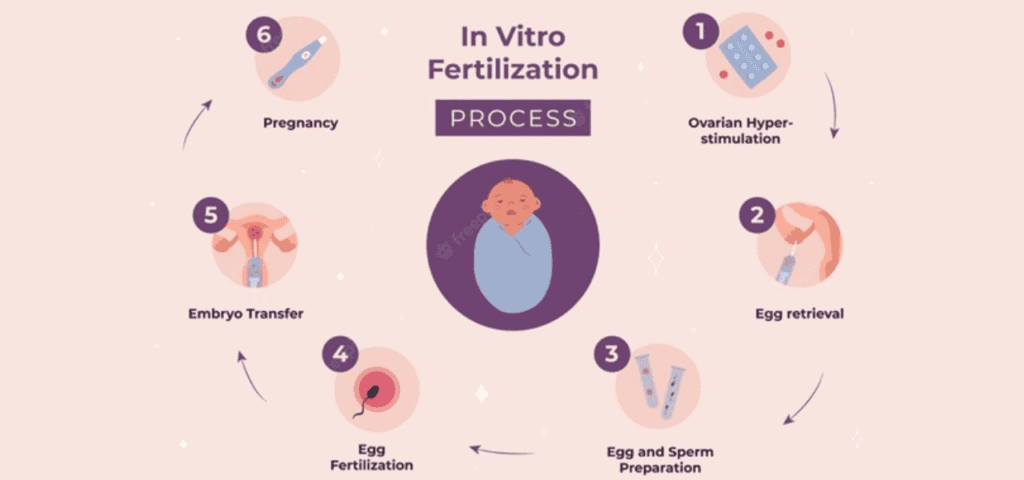
Will Insurance Cover IVF? Everything You Need to Know About Costs, Coverage, and Real-Life Options
April 13, 2025
Chicago IVF: Your Ultimate Guide to Fertility Success
April 13, 2025Everything You Need to Know About Clinic IVF: A Deep Dive into Fertility Treatments
Welcome to the world of clinic IVF—a journey filled with hope, science, and a little bit of mystery. If you’re reading this, you’re probably curious about in vitro fertilization (IVF), maybe even considering it for yourself or a loved one. IVF isn’t just a medical procedure; it’s a life-changing experience that blends cutting-edge technology with deeply personal dreams. In this article, we’ll peel back the curtain on clinic IVF, sharing details you won’t find in a quick Google search—think hidden challenges, surprising perks, and practical tips to make the process smoother. Whether you’re new to the idea or already knee-deep in research, we’ve got you covered with a fresh, human take on it all.
Let’s dive in and explore what clinic IVF really entails, from the science behind it to the little-known quirks that patients wish they’d known sooner.
What Is Clinic IVF, Anyway?
IVF stands for in vitro fertilization, which basically means “fertilization in glass.” It’s a process where eggs and sperm meet outside the body, in a lab, before the resulting embryo is placed back into the uterus. Clinics specializing in IVF offer this as a solution for people struggling with infertility—whether due to age, medical conditions, or even unexplained reasons.
But it’s not just about mixing cells in a dish. Clinic IVF involves a team of experts—doctors, embryologists, nurses—working together to boost your chances of having a baby. It’s a blend of high-tech tools and human care, and it’s more common than you might think. In 2023 alone, over 300,000 IVF cycles were performed in the U.S., according to the latest fertility stats.
What sets clinic IVF apart? It’s tailored to you. No two journeys are the same, and that’s where the magic (and sometimes the stress) comes in. Let’s break it down step-by-step so you know exactly what to expect.
The IVF Process: A Step-by-Step Guide
IVF can feel like a rollercoaster, but knowing the steps ahead of time makes it less intimidating. Here’s how it typically unfolds in a clinic:
Step 1: Getting Your Body Ready (Ovarian Stimulation)
The goal here is to get your ovaries to produce multiple eggs instead of the usual one per month. You’ll take hormone injections—usually for 8-14 days—to kick things into gear. These shots sound scary, but they’re just tiny needles, like the ones diabetics use.
- What it feels like: A little pinch, maybe some bloating as your ovaries wake up.
- Pro tip: Set a daily alarm for your shots. Consistency is key!
Step 2: Egg Retrieval
Once your eggs are ready, a doctor uses a thin needle (guided by ultrasound) to collect them from your ovaries. You’re under light sedation, so it’s painless—most people say it’s like taking a nap.
- Fun fact: The average woman produces 10-20 eggs per cycle, but quality matters more than quantity.
- Recovery tip: Rest up for a day and sip lots of water to bounce back faster.
Step 3: Sperm Meets Egg
In the lab, the embryologist combines your eggs with sperm (either from a partner or donor). This can happen naturally or with a boost called ICSI (intracytoplasmic sperm injection), where a single sperm is injected into an egg.
- Did you know? Embryologists sometimes play soft music in the lab because they swear it helps embryos grow better. No hard proof, but it’s a cute quirk!
Step 4: Embryo Growth
The fertilized eggs grow into embryos over 3-5 days. The clinic monitors them closely, picking the strongest ones for transfer.
- Science bit: About 60-70% of fertilized eggs make it to this stage, per recent studies.
Step 5: Embryo Transfer
A doctor places one or two embryos into your uterus using a thin tube. It’s quick, no sedation needed, and feels like a routine gyno exam.
- What to expect: Mild cramping, maybe some spotting. Take it easy afterward.
Step 6: The Waiting Game
Now, you wait 10-14 days for a pregnancy test. This “two-week wait” is infamous for driving people up the wall—more on coping with that later!
Each step is a mini-milestone, and clinics tweak the process based on your unique needs. That’s why picking the right one matters so much.
How to Choose the Perfect IVF Clinic
Not all clinics are created equal. Some have fancy waiting rooms and free coffee, but what really counts is their success rate, staff vibe, and how they handle your questions. Here’s what to look for:
Success Rates Aren’t Everything
Clinics love flaunting their numbers, but dig deeper. A 40% success rate might sound great, but if they only take young, healthy patients, it’s less impressive. Check the CDC’s fertility clinic database for stats broken down by age and condition.
- ✔️ Do: Ask for success rates specific to your situation (e.g., over 35, PCOS).
- ❌ Don’t: Fall for glossy ads without checking the fine print.
The Human Touch
A good clinic feels like a partner, not a factory. Are the nurses patient when you call with a million questions? Does the doctor explain things without rushing?
- Real story: One patient said her clinic sent her a handwritten “good luck” note before transfer day. Small gestures like that stick with you.
Hidden Costs
IVF isn’t cheap—$12,000-$15,000 per cycle is average, not counting meds. Ask about payment plans, insurance coverage, or even refund programs if it doesn’t work.
- Tip: Some clinics offer “shared risk” deals where you get money back after a set number of failed cycles. Worth asking!
Tech and Trends
Top clinics use the latest tools, like AI to pick the best embryos or genetic testing (PGS) to screen for issues. Dr. Jane Miller, a fertility specialist in California, says, “Technology’s advancing so fast—clinics that don’t keep up are doing patients a disservice.”
Picking a clinic is like dating—you’ll know when it feels right. Trust your gut, but back it up with research.
The Emotional Side of IVF: What No One Tells You
IVF isn’t just physical—it’s an emotional marathon. Plenty of articles talk about the medical stuff, but the feelings? Those hit harder than you expect.
The Rollercoaster of Hope and Doubt
One day you’re dreaming of baby names; the next, you’re googling “why did my cycle fail?” It’s normal to bounce between excitement and fear.
- Coping trick: Write down three things you’re grateful for each day. It sounds cheesy, but it keeps you grounded.
The Two-Week Wait (TWW) Survival Guide
This is the stretch between transfer and test day. Every twinge feels like a sign, and you might obsess over symptoms (or lack thereof).
- ✔️ Do: Distract yourself—binge a show, knit, anything!
- ❌ Don’t: Test early. False negatives will wreck you.
How It Affects Relationships
IVF can bring couples closer—or test their limits. Partners might feel helpless watching you jab needles, and you might feel guilty for dragging them into it.
- Real talk: One woman said her husband started baking bread during their IVF cycles. “He needed something to control,” she laughed. It became their thing.
The Secret Club
Once you’re in the IVF world, you notice it everywhere—friends confessing their own cycles, strangers swapping tips online. It’s a weirdly comforting bond.
Dr. Emily Carter, a reproductive psychologist, puts it perfectly: “IVF patients carry a quiet strength. They’re warriors, even when they don’t feel like it.” You’re not alone, even when it feels that way.
Little-Known IVF Facts That’ll Surprise You
Let’s lighten things up with some quirky tidbits most people don’t know about clinic IVF:
- Embryo Adoption Exists: Yep, you can adopt someone else’s frozen embryo if making your own isn’t an option. It’s like a fertility hand-me-down!
- Pineapple Core Trick: Some swear eating pineapple core after transfer helps implantation (something about bromelain). No solid proof, but it’s a fan favorite.
- Frozen Is the New Fresh: Studies from 2023 show frozen embryo transfers often beat fresh ones—higher success rates and fewer complications.
- Sperm Can Be Picky: If sperm quality’s low, clinics might test DNA fragmentation. It’s like a quality check before the big dance.
These nuggets don’t make headlines, but they’re the kind of trivia IVF veterans love sharing over coffee.
Busting IVF Myths: What’s True, What’s Not?
Misinformation swirls around IVF like flies at a picnic. Let’s clear the air:
Myth 1: IVF Babies Are “Unnatural”
Nope. They’re conceived in a lab, sure, but they grow in a womb like any other baby. The tech just gives nature a nudge.
Myth 2: It Always Works on the First Try
Sadly, no. Success rates hover around 30-40% per cycle for women under 35, dropping with age. It’s a numbers game, not a guarantee.
Myth 3: IVF Means Twins Every Time
Not true! Multiple births happen less now—clinics often transfer one embryo to avoid risks. Twins are still possible, but not the norm.
Myth 4: It’s Only for Women
Men’s fertility matters too. About 40% of infertility cases tie back to sperm issues, and clinics test both partners.
Knowing the truth keeps expectations real and stress low.
IVF and Your Body: What Changes?
IVF messes with your system in ways you might not expect. Here’s the rundown:
Hormones Galore
Those injections? They flood you with FSH and LH (follicle-stimulating hormone and luteinizing hormone). You might feel moody, bloated, or tired.
- Fix it: Light walks and comfy clothes help. Avoid tight jeans!
Weight Fluctuations
Some gain 5-10 pounds from water retention during stimulation. It drops off after, so don’t panic.
Ovarian Hyperstimulation Syndrome (OHSS)
A rare side effect where ovaries overreact. Symptoms include severe bloating or pain—call your clinic if it hits.
- Stats: Less than 5% of patients get moderate OHSS, per 2024 research.
Long-Term Effects
Good news: Studies (like one from the NIH in 2023) show IVF doesn’t raise cancer risk or wreck your health down the line.
Your body’s tougher than you think—it just needs TLC during the ride.
Diet and Lifestyle: Boosting Your IVF Odds
What you eat and do can nudge your success rate up. Here’s the practical stuff:
Foods to Love
- Eggs & Avocados: Packed with healthy fats for hormone balance.
- Leafy Greens: Folate helps embryo development.
- Nuts & Seeds: Zinc and selenium boost egg and sperm quality.
Foods to Skip
- Sugary Drinks: They mess with blood sugar and inflammation.
- Processed Junk: Think chips, fast food—empty calories, no nutrients.
Lifestyle Tweaks
- ✔️ Sleep: Aim for 7-9 hours. Tired bodies don’t make babies well.
- ✔️ Exercise: Light yoga or walking, not marathons—overdoing it stresses ovaries.
- ❌ Smoking: Cuts success rates by up to 50%. Quit now.
A 2024 study from the American Society for Reproductive Medicine found women who ate a Mediterranean-style diet had 15% higher implantation rates. Small changes, big payoff.
The Money Talk: How to Afford IVF
IVF’s pricey, but there are ways to soften the blow:
Insurance Hacks
Only 19 U.S. states mandate some infertility coverage. Check your policy—some cover diagnostics, others meds.
- Ask this: “Does my plan include IVF cycles or just testing?”
Financing Options
- Loans: Banks like Prosper offer IVF-specific plans with decent rates.
- Grants: Groups like BabyQuest give thousands to qualifying families.
Savings Strategies
- Cut extras: Skip takeout for a few months—$500 adds up fast.
- Clinic deals: Some offer discounts for multiple cycles upfront.
Money’s tight for most, but where there’s a will, there’s a way.
IVF for Special Cases: Beyond the Basics
IVF isn’t one-size-fits-all. Here’s how it adapts:
Over 40? No Problem
Success drops with age, but donor eggs or embryos can push rates back up to 50% or more.
- Trend alert: More women over 40 are freezing eggs earlier—up 20% since 2020.
Single or Same-Sex Couples
Clinics welcome everyone. Single folks use donors; same-sex couples mix and match sperm, eggs, or surrogates.
PCOS and Endometriosis
These conditions complicate things, but IVF tweaks—like longer stimulation—help. Success rates still hit 30-40% with the right care.
Dr. Mark Evans, an IVF pioneer, says, “The beauty of modern IVF is its flexibility—there’s a path for almost anyone.” That’s the spirit driving clinics today.
The Future of IVF: What’s Coming?
IVF’s evolving fast. Here’s what’s on the horizon:
- AI Boost: Algorithms now predict embryo success with 85% accuracy, per 2024 trials.
- Gene Editing: Still experimental, but it could nix hereditary diseases pre-implantation.
- At-Home Monitoring: Wearables to track hormone levels—less clinic visits, more comfort.
The future’s bright, and clinics are racing to bring it to you.
Your IVF Toolkit: Practical Tips to Thrive
Let’s wrap up with a go-to guide for rocking your IVF journey:
Before You Start
- ✔️ Research clinics like it’s your job.
- ✔️ Stock up on cozy socks—those exam rooms are cold!
- ❌ Don’t skip the financial chat with your partner.
During the Cycle
- ✔️ Keep a journal—track shots, moods, everything.
- ✔️ Lean on friends who get it—online forums are gold.
- ❌ Don’t Google every symptom. You’ll spiral.
After Transfer
- ✔️ Rest, but don’t bed-lock—light movement’s fine.
- ✔️ Treat yourself—a cupcake won’t hurt the odds.
- ❌ Don’t test early. Patience pays.
You’ve got this. IVF’s tough, but you’re tougher.
Let’s Chat: Your Turn!
IVF’s a wild ride, and no article covers it all. What’s on your mind? Drop a question below—maybe about costs, clinic picks, or how you survived the two-week wait. Share your story, too! Did a weird trick (pineapple core, anyone?) work for you? Let’s build a little community right here—your thoughts could help someone else starting out.
What’s one thing you wish you’d known before your first IVF cycle? Spill it!
